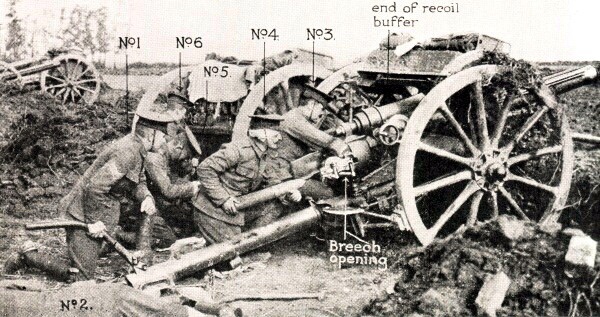At the outbreak of the Great War, the Royal Regiment of Artillery comprised the Royal Horse Artillery, the Royal Field Artillery and the Royal Garrison Artillery.
The Royal Horse Artillery was armed with light, mobile, horse-drawn guns to support the cavalry although in practice they supplemented the Royal Field Artillery.
The Royal Field Artillery was the largest arm of the artillery and was organised into brigades attached to divisions or higher formations. It was responsible for medium calibre guns and howitzers that were deployed close to the front line, and for the heavier of the trench mortars developed during the Great War to meet the unusual conditions of war on the Western Front; the lighter mortars ‘were operated by the infantry.
The Royal Garrison Artillery was developed from the artillery based in fortresses around the British coast. At the outbreak of the Great War the army had little heavy artillery but during the war Royal Garrison Artillery grew substantially, armed with heavy, large calibre guns and howitzers positioned some distance behind the front line which had enormous destructive power.
The following brigades, formed from the original 2nd Welsh Brigade of the Royal Field Artillery (Territorial Force) which included the 3rd and 4th Glamorgan Batteries, the Cardigan Battery and the 2nd Welsh Ammunition Column, spent time in Bedford and/or the Bedford area:
The 1/2nd Welsh Brigade, Royal Field Artillery the first line Territorial unit comprising men who were both fit and had volunteered to serve overseas. August 1914 mobilized and concentrated in the general area of Northampton under the initial Home Defence scheme, later moving to Cambridge and then Bedford. July 1915 the 53rd (Welsh) Division infantry embarked for service at Gallipoli and later Egypt and Palestine. The Divisional artillery remained at Bedford and was rearmed in October with modern 4.5-inch howitzers. Ordered to join the British Expeditionary Force on the Western Front, it sailed for France from 20 November 1915 and concentrated near Pont Remy by five days later. Parties were sent to various divisional artilleries for instruction in front line duties. Preparing to leave France the next year, entrainment began on 1 February 1916, embarkation at Marseilles began two days later and by 22 February 1916 the artillery had concentrated at Beni Salama in Egypt and came once again under command of the 53rd Division.
The 2/2nd Welsh Brigade, Royal Field Artillery the reserve or second line unit comprising those who (before 1916 and the advent of compulsion) declined the overseas obligation, or were unfit or raw recruits. September 1914 raised in Cardiff. April 1915 reached Northampton. August 1915 moved to Earlswood. November 1915 moved to Bedford, attached to the 68th (2nd Welsh) Division. May 1916 retitled the CCCXLI (341st) Brigade Royal Field Artillery (Territorial Force) and the Batteries became simply “A”, “B”, and “C”. By September 1916 the artillery was disposed between Austin Cannon, Old Warden and Howbury. By May 1917 the 68th (2nd Welsh) Division headquarters was at Bungay, Suffolk and the artillery at Huntingdon and Flixton. September 1917 moved to Langley and then Harleston. By Spring 1918 reached Herringfleet and then Henham. By the end of the war were at Herringfleet and Harleston again. During all this time the units trained and sent out officers and men to the 53rd (Welsh) Division and other formations.
The following detachment of the Royal Garrison Artillery spent time in Bedford:
Welsh (Caernarvonshire) Heavy Battery attached to the 53rd (Welsh) Division. The Battery stayed in Bedford when the Division departed in July 1915 for Gallipoli, and subsequently departed independently for France in March 1916 and joined the XXIII HA Brigade.
